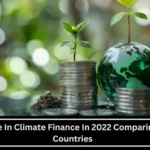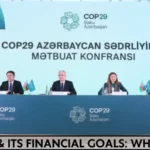FM Sitharaman; The search for a sustainable future finds the world at a pivotal point and the need to close the finance gap in sustainable development has never been more evident with the Global South used to characterize poor countries bearing the most weight of climate change and other global concerns.
India’s FM Sitharaman underlined on August 17, 2024, during the Finance Ministers’ Session of the third Voice of the Global South Summit, this urgent requirement.
The $4 Trillion Financing Gap: Strategy By FM Sitharaman
In her speech, FM Sitharaman underlined the pressing need to fill the $4 trillion financial gap in order to hasten forward advancement of the Sustainable Development Goals (SDGs).
According to a recent assessment published by the United Nations Conference on Trade and Development (UNCTAD), poor nations are facing a shockingly $4 trillion investment shortfall required to reach the SDGs.
Achieving the 17 interconnected global goals which seek to eradicate poverty, save the earth, and guarantee prosperity for all by 2030—is seriously challenged by this divide.
For nations in the Global South especially, the situation is grim. Already under great financial strain, these countries must deal with issues including debt, restricted capital availability, and the negative effects of climate change. The SDGs were meant to solve these problems, but without enough funding, the targets would stay unreachable.
The Role of Foreign Direct Investment in Clean Energy
UNCTAD estimates that the $544 billion worth of foreign direct investment (FDI) in renewable energy drawn in by developing nations in 2022 was significantly less than required to close the finance gap.
This shortage emphasizes how urgently more investment in sustainable development projects especially in clean energy is needed to fight climate change and advance global South economic development.
Achieving the SDGs depends on the world turning toward a low-carbon economy. Still, the low FDI in renewable energy exposes an alarming trend.
Although industrialized countries have made progress in lowering their carbon footprints, poorer countries still battle with insufficient means to support their changes. The $4 trillion disparity emphasizes the need of creative financial ideas and more global cooperation to properly mobilize resources.
India’s Commitment to Sustainable Development
India, one of the most vocal members of the Global South, has led front-stage in promoting sustainable development. Under the direction of FM Sitharaman and the Indian administration, the nation has made notable efforts to match national policies with the SDGs. India’s ambitious aspirations for social fairness, poverty reduction, and renewable energy show clearly its will to reach these objectives.
Aiming for 500 GW of renewable energy by 2030, India’s approach to addressing climate change largely depends on this kind of source of electricity. Along with other projects targeting water security, better access to healthcare and education, and support of sustainable agriculture, the nation has started.
These projects tie up with the SDGs and show India’s will to set an example for the world towards sustainable development. But as FM Sitharaman noted, India, like many other poor countries, struggles greatly to gather the required funds to reach these targets.
Particularly for nations in the Global South lacking the financial and technical means to carry out major sustainable development initiatives, the $4 trillion funding shortfall seriously hinders development.
The Voice of the Global South: A Call for Global Solidarity
The third Voice of the Global South Summit gave underdeveloped nations a forum to express their worries and offer their opinions on world events, especially the finance shortfall in sustainable development. Using this chance, FM Sitharaman demanded more world solidarity and cooperation to help the Global South overcome its problems.
Not only does the finance gap affect developing nations; it is a worldwide issue needing a coordinated response. Developed nations have an obligation, FM Sitharaman underlined, to assist the Global South in reaching the SDGs. Increased financial aid, technological transfer, and capacity-building programs could all be ways this help shows up.
FM Sitharaman also underlined the importance of creative financial tools to close the financing disparity. This covers public-private partnerships, climate financing, and green bonds to help gather funds for initiatives in sustainable development. Using these instruments will enable the world to assist underdeveloped nations in acquiring the money required to meet the SDGs.
Climate Change: A Defining Challenge for the Global South
One of the biggest obstacles the Global South faces still is climate change. Developing nations most feel the effects of climate change—extreme weather events, rising sea levels, and shifting agricultural patterns, especially in relation to contemporary countries are frequently the least suited to adjust to contemporary times, so the requirement of sustainable development is even more critical.
Achieving the SDGs depends on addressing climate change, FM Sitharaman underlined. The Global South would suffer to reach its development targets without significant investment in climate resilience and adaptation strategies.
Closing the $4 trillion financial shortfall is thus absolutely vital. Funding development projects is one problem; another is making sure these initiatives are sustainable and can resist effects of climate change.
The Way Forward: Bridging the Financing Gap
One has to use a multifarious strategy to close the $4 trillion financial shortfall. First and most importantly, developing nations must get far more international cash flows.
This covers public as well as private sector investments. By enacting wise economic policies, enhancing governance, and lowering regulatory obstacles, governments in the Global South also have a proactive role in building a climate fit for investment.
Apart from conventional sources of money, one should investigate fresh and creative financial instruments. For funding ecologically friendly initiatives, for instance, green bonds have become rather popular.
In the Global South, similarly, climate financing projects can offer much-needed funds for adaptation and mitigating projects.
Additionally very important in helping to close the financing gap are international financial institutions as the World Bank and the International Monetary Fund.
To enable underdeveloped nations reach the SDGs, these organizations can offer low-interest loans, grants, and technical support. They can also help governments create and carry out policies supporting sustainable development.
Conclusion
Though it presents a great obstacle, the $4 trillion financing shortfall is not insurmountable. Closing this gap and accelerating SDG development is achievable with the correct mix of international cooperation, creative finance, and strong national leadership from nations like India.
As FM Sitharaman underlined, action is absolutely needed. Our capacity to coordinate the required resources for sustainable development will determine the fate of the Global South and the Earth.
To reach the SDGs, the global community has to stand in solidarity with the Global South and enable it to drive its development. We can guarantee a sustainable and rich future for all by means of cooperation only.










